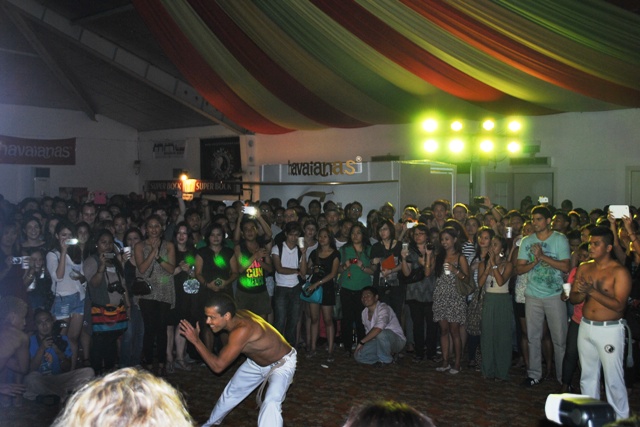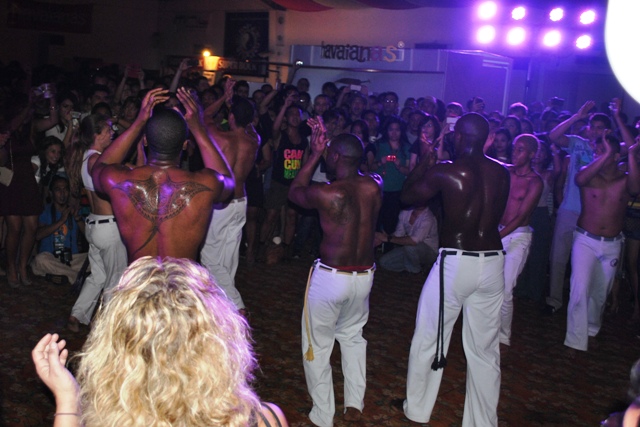Filtered By: Lifestyle
Lifestyle
Capoeira puts the 'art' in martial arts
By AMANDA LAGO, GMA NEWS
As far as martial arts go, you do not get more "art" than capoeira.
For one, it's certainly not as ubiquitous as boxing or muay thai, at least not in this country, and its relative distance from the mainstream certainly ups its hipster appeal.
But more than that, capoeira goes beyond the usual kicks and punches, with combat looking more like a well-choreographed dance and sounding more like the Carnaval than a fight. 
Capoeiristas enjoy a game of capoeira at the 10th annual Brasilipinas party last February 8, 2013 at the Rockwell Power Plant. Photos from Rockwell Power Plant
As described by Alessandro Coqueiro, "capoeira is an art form from Brazil." Coqueiro is more popularly known as Mestre Fantasma, the head teacher of Escola Brasiliera de Capoeira (EBC).
"It's a combination of martial arts, music, dance, and history," he told GMA News Online at the 10th annual Brasilipinas party last Feb. 8 at the Rockwell Power Plant Mall.
Capoeira games happen in a circle called a roda (pronouced "hoda"). Capoeristas clap their hands and some play Brazilian instruments. All of them sing. Two capoeiristas go into the roda and proceed in a dance of flying kicks, headstands, handstands, and other wow-worthy acrobatics.
"For me, it's a very complete art form in the sense that you have movement, you also have music, you have culture, you have history, you have folklore," shared Richard Dacalos or Pirulito, a capoeirista for the past eight and a half years who teaches at White Space in Katipunan.
The capoeira culture as shared by him is a fascinating one.
New capoeiristas who have been training for a few months or those who move up a rank go through a batizado (baptism) where they are welcomed into the capoeira world and given a capoeira name based on their distinctive traits. Classes focus on the movements and techniques sometimes, on the music at other times, or on the folklore or the history or the samba. Capoeristas even learn some Portugese over the course of their training.
For musician Nyko Maca, also a capoeira teacher known as Formada Andorinha, capoeira has put her in touch with Brazilian culture, which she incorporates in her music.
As Fantasma said, the martial art is more than a physical exercise.
"Aside from all the benefits that any physical activity can give, capoeira can give a little bit more than that because we don't work only the body, we work on the mind," he explained. 
Partygoers join the capoeira around a roda at Brasilipinas 2013.
"We work on the friendship, we work on the respect, on the family. And capoiera is great for that, it's perfect," he said.
As it turns out, community is as crucial to capoeira as culture.
"At the heart of what we do is really bringing people together and it really is community in the sense that you can't do capoeira alone," Dacalos said.
"You can train the movements on your own, but that really isn't capoeira. You do capoeira with a partner. You do capoeira in a roda, and to have a roda, you need people. And for you to sing, you need lots of people, you need people playing instruments. It's fueled by group dynamic," he explained.
Pinoys learn easily
It's no surprise that Filipinos have taken to capoeira so well. While not the most popular game in the Philippines yet, Dacalos shared that Filipino capoeiristas have a good reputation in international capoeira circles.
"Really, here in the Philippines, you can ask any of the capoeira teachers the same—it's one of the best in Asia, Southeast Asia. We have one of the best schools, best energy. You can ask, and that's usually what they say. We have a really high level of capoeira here in the Philippines," he said.
Mestre Fantasma—who has been living and teaching capoeira in the Philippines for the last nine years—said himself that Pinoys learn capoeira easily.
"It's not, it's not [hard to teach capoeira to Filipinos]. We both share the same passion for music, and music in capoeira is everything. So for Filipinos, it's very easy to get into capoeira," he shared.
For those who are interested in trying out the martial art, Dacalos suggested taking more than one class.
"Sometimes when you just take one session, you might have a preconception of what it's all about when you're only learning one part of something that's very, very big," he said.
But more importantly, he advised beginners to just "have fun." It would seem that capoeira provides a lot of opportunity for that anyway.
As Fantasma said, "Come to the class. If you don't want to join the first time, which you should, you can watch, and I can guarantee you something very different is gonna touch your life." —KG, GMA News
More Videos
Most Popular



